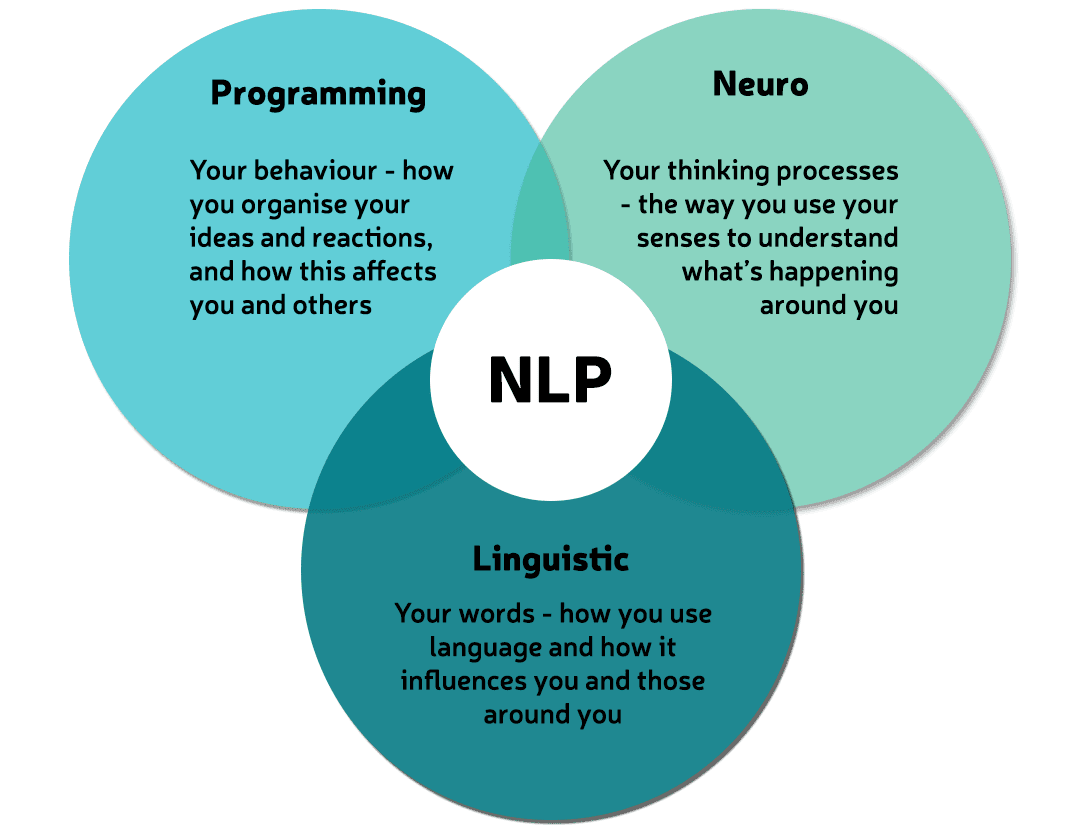NLP has been around for a long time. And you can get certified online these days for about $25. Of course, the tools are only the tools. I’m fascinated by all these life coaching trainings showing up online. As if it were an easy career path for a recent high school or college graduate. And when you listen to these masters of life coaching, in their 20’s it can be refreshing. Not very enlightening, in my experience, but they sure are full of energy and enthusiasm.
But the tools of NLP are very foundational to getting yourself (or your client – in the case of coaching) in better control of how your thoughts and moods and actions are connected to the WORDS you are saying to yourself.
Neuro – involving the brain
Linguistic – using language
Programming – mantras, repeating affirmations, turning negative thoughts around to positive actions
You can change your strategy
to one that produces the results you want.
Here are the fundamental tenants of NLP.
NLP’s creators claim there is a connection between neurological processes (neuro-), language (linguistic) and behavioral patterns learned through experience (programming), and that these can be changed to achieve specific goals in life. – more from Wikipedia
The Presuppositions of NLP
Here are the 13 presuppositions of NLP.
1. Communication is redundant. Both inner and outer communication is largely a description of inner pictures, sounds, and feelings. The information we mull over and express to others is always some combination of these three senses or modalities. Whether or not we’re aware of it, these three modalities are redundant. There is always an inner picture and sound that goes with a feeling, for example.
No thought stands alone. Pictures, sounds, and feelings accompany all communication.
2. The meaning of your communication is the response that you get. Your intention while communicating means less than the other person’s response. If you’re giving someone helpful feedback and they become offended, your communication is not helpful, but offensive. Accepting that, you can adjust your communication accordingly. With this presupposition, we don’t waste time defending our intentions but focus more on getting a desirable response. (I have some issues with this oversimplification of focusing on the results we want rather than peace, love, and UNDERSTANDING our partner’s desires.)
It’s all about your MINDSET.
3. People respond to their map of reality, not to reality itself. NLP and coaching endeavor to change someone’s inner map of reality or mindset, and not reality itself, which no one can know for certain. Reality itself is a perception based on inner beliefs, past experience, and other perceptual filters. These filters come together to form inner maps of reality. By focusing our change work on inner perceptions, a client’s reality can change because her map has been changed.
4. Requisite variety. The element in a system with the most flexibility will usually be the controlling element. In many cases, getting stuck indicates a lack of flexibility. Perhaps we don’t see alternatives or are too rigid to apply them. People who are flexible can adapt to changing circumstances and keep moving forward.
5. People work perfectly. No one is wrong or broken; it’s simply a matter of finding out how you are effectively producing undesirable results so that you can change your strategy to one that produces the results you want.
6. People always make the best choice available to them at the time. There may be a wealth of better choices we haven’t explored yet. It’s possible that people are simply unaware of better alternatives if they are making unhealthy choices. It may also be likely that healthier choices do not appear feasible. Or that their poor choices are more out of habit and bad information rather than an intentional sabatoge.
7. Every behavior is useful in some context. You may not like a certain behavior in yourself or your partner, but most behaviors aren’t “bad” but simply applied in the wrong context. For example, fist fighting. It may not be appropriate in a grocery store, but fist-fighting is the right thing to do inside a boxing ring.
8. Choice is better than no choice. When we only have one choice, we’re like robots. Two choices keep us in a dilemma. Three or more choices is true choice, which is ideal.
9. Anyone can do anything. If one person can do something, it is possible to model it and teach it to anyone else. This is the presupposition upon which most of NLP was built. Teaching the specific mental strategies and behaviors experts use helps others duplicate their success.
10. People already have all the resources they need. What they need is access to these resources at appropriate times and places.
11. There is no such thing as failure, only feedback. Every response can be utilized.
12. Chunking. Anything can be accomplished (by anyone) if you break the task down into small enough chunks.
13. Positive Intent. Behind every behavior is a positive intention. Even though a behavior might be harmful, such as smoking, the intention behind the behavior is positive. Smokers smoke to relax, to socialize, the express their independence, and so on. This principle applies to almost all behaviors.
I hope you can find some juicy nuggets in those 13 concepts. You’ve probably seen or heard of most of them. NLP was one of the big breakthroughs in “therapy” back in the 70’s. And some of the principles are in most coaching and counseling toolboxes. Even masterplans like The Secret are built around how your mindset and thoughts create your reality and your future reality.
I tend to think that our consistent and authentic actions create our future reality. I also KNOW that my thoughts, words, and moods, form the energy or lack of energy I have for striving and working towards my goals. Some of NLP is too focused on getting the results from others that you want. I love the “getting results inside my own mind” idea that these tools are good for anyone to have at their disposal. For example: when working on a huge problem, Chunking is the primary strategy for taking steps to move forward with your plan.
There is a ton of NLP books and “classes” for people who are interested in using the language and behavioral patterns of the mind to affect positive changes in their own lives. As a single process or tool for holistic life coaching, I think NLP is a bit thin. Pair that with less than 25-or-so years on the plan, years of living the life, and I think there is a problem that people are buying $25 NLP “certification” programs and hanging up their shingle to “coach” people. But hey, I’m not a millennial, and perhaps that perky and excitable life coach with her shiny “mastermind coaching boot camp” is better positioned to serve people like herself.
I hope that I might be perceived as the wisened male figure who can give counsel, NLP, and ideas from a large range of tools, theories, and life stories, to help others. That’s my hope. That’s why I do what I do.
Namasté,
John McElhenney – life coach austin texas
Facebook | Instagram | Pinterest | @wholeparent
IMAGE: Paraiso Yoga – Sayulita Mexico.





How I Can Help
I am a relationship coach and a dating coach. I coach women and men in 1 x 1 ZOOM calls. I work in monthly blocks (4 sessions). We establish a relationship. I become your wingman in navigating and sorting through the bullshit of dating and relationships. If you are here, you’ve probably already read some of my opinions. If we’re a fit, we will both know on our first call. For SEPT-OCT I’m offering a 1 HR introductory call rather than my usual 30-minutes.
Related posts:
Brené Brown’s Ground-breaking TED Talks